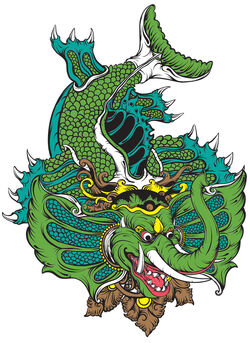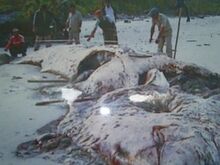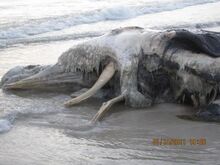| Gajah Mina | |
|---|---|
 | |
| [[{{{map}}}|250px]] | |
| Background | |
| Type | Sea Monster |
| First Sighting | Antiquity |
| Last Sighting | 2016 |
| Country | Indonesia, Malaysia |
| Habitat | Sea |
| Possible Population | Small |
Gajah Mina is a sea cryptid commonly found in Indonesian archipelago. Gajah Mina’s body is a combination of elephant and fish. The cryptid is widely known by seafaring Malay and Indonesian people. The name means “fish elephant”, and not to be confused with Gajah Laut, which means “elephant seal”.
In Balinese Hindu culture, Gajah Mina is one of the 7 mythological animals (Makara). The shape of elephant-headed fish often painted or carved into candi (temple) as ornaments. As many archeological temples has Gajah Mina ornaments in them, it looks like that the Gajah Mina has been known since antiquity.
Description
Description of Gajah Mina comes from the coastal village elders. The elders said that the creature is as large a whale, has trunk like elephant, fur in its body, a pair of tusk, and in some cases, wide ears. If a Gajah Mina found dead on a coast, villagers usually come to collect its body parts, like chunk of fur, tusk, or bone. Gajah Mina believed to live in deep water, so their sighting is somewhat rare.
The head of Sri Serindit Museum of Natuna, Zaharudin, said that the length of Gajah Mina can reach 20 meters. Called “gajah” (elephant) because it has tusk and trunk. He said that Gajah Mina is a tusked animal, with skin that unlike a fish. The skin has soft fur, so it is not whale. Zaharudin also said that fishermen are afraid of encountering these creature on the sea. Many fishermen attribute Gajah Mina with bad luck.
Sightings

Carcass found in Dungun Beach
On 13 January 2005, a white furred carcass was found in Dungun beach, Riau. The carcass found by nearby villagers, and parts of it were taken by them. The villager believed the carcass is from the now-rare Gajah Mina. The length of the carcass is 12.4 m, length of the tail base to tail end 1.8 m, tusk length is 2.4 m, skin thickness is 10 cm, the length and width of the flipper is 78 and 47 cm respectively.
On 20 June 2010, a “sea elephant” is seen by a fisherman named Amir. He was diving at that time to catch fishes, and saw the creature trapped in his nets. Too afraid to get closer to the huge creature, he chose to avoid the location for some time. 3 months later when he came back, the creature is already became a skeleton.

A carcass found in Langkawi, Malaysia
Early August of 2013, fishermen of Subi found a floating carcass that they believed belong to Gajah Mina. The fishermen tried to tow the thing to land using 4 boats. Before reaching land, the tusk, which is where they tie the rope, detached from the body. As a result they only took the tusk. The fishermen said the carcass is as big as a 250 GT ship, about 15-30 meter in length.
As reported by AntaraKepri.com (a news website), in Serasan island, Natuna, a villager named Sanjaya saw 6 meter long thing beached on Sisi beach. At first he thought it was a whale, as he got closer he saw long tusk, trunk on its face, wide ear, and whale-like tail. Many villager come to see and dragged it to the land, then bury the thing so it won’t cause disease. This event happened on 14 February 2016.
Explanation
- Plausible explanation is that they are actually a decomposed whale carcass. Decomposed whale carcass usually make an appearance of white “fur”, and the trunk and ears might be some parts that is about to disintegrate from the main body. The appearance of tusk is actually the lower jawbone, which could be seen when decomposing.
- It could also misidentified elephant seal. Altough no species of elephant seal exist in Indonesian and Malaysian waters.
- Another explanation is Sirenian. Dugongs are common around South East Asian coastal areas.
- Despite those explanation, village elders and middle aged fishermen convince that they have seen the living creature in their younger days. The sea near Kalimantan, has not less than 20 whale species that emigrate around the island. The fisherman knew the difference between a common whale and a furred Gajah Mina.
Trivia
- Inland Dayak people consider the Gajah Mina as native hippopotamus. The sighting of hippo comes from Barito and Rungan river, Central Kalimantan. As a note no hippo is living in Borneo, so Kalimantan hippopotamus may also considered as a cryptid.
- Indonesian regard the Gajah Mina as Paleo-creature (i.e. like mammoth and sabre toothed cats).

